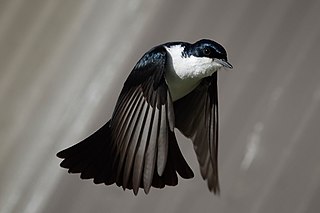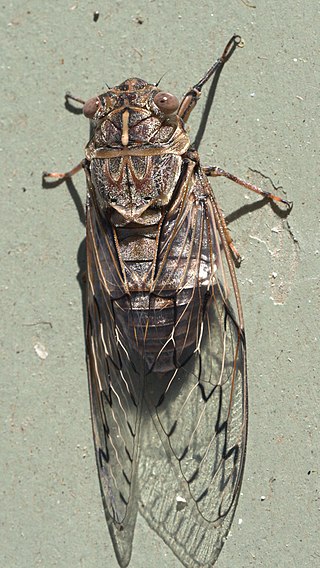
The cicadas are a superfamily, the Cicadoidea, of insects in the order Hemiptera. They are in the suborder Auchenorrhyncha, along with smaller jumping bugs such as leafhoppers and froghoppers. The superfamily is divided into two families, the Tettigarctidae, with two species in Australia, and the Cicadidae, with more than 3,000 species described from around the world; many species remain undescribed. Nearly all of cicada species are annual cicadas with the exception of the few North American periodical cicada species, genus Magicicada, which in a given region emerge en masse every 13 or 17 years.

Scissors are hand-operated shearing tools. A pair of scissors consists of a pair of blades pivoted so that the sharpened edges slide against each other when the handles (bows) opposite to the pivot are closed. Scissors are used for cutting various thin materials, such as paper, cardboard, metal foil, cloth, rope, and wire. A large variety of scissors and shears all exist for specialized purposes. Hair-cutting shears and kitchen shears are functionally equivalent to scissors, but the larger implements tend to be called shears. Hair-cutting shears have specific blade angles ideal for cutting hair. Using the incorrect type of scissors to cut hair will result in increased damage or split ends, or both, by breaking the hair. Kitchen shears, also known as kitchen scissors, are intended for cutting and trimming foods such as meats.

The black-billed cuckoo is a New World species in the Cuculidae (cuckoo) family. The scientific name is from Ancient Greek. The genus name, kokkuzo, means to call like a common cuckoo, and erythropthalmus is from eruthros, "red" and ophthalmos, "eye".

The scissor-tailed flycatcher, known as swallow-tailed flycatcher or scissorstail, is a long-tailed insectivorous bird of the genus Tyrannus, whose members are collectively referred to as kingbirds. Its scientific name used to be Muscivora forficata until it was changed to Tyrannus forficatus. It is found in North and Central America, and is Oklahoma's State Bird.

Cicadas of the genus Neotibicen are large-bodied insects of the family Cicadidae that appear in summer or early fall in eastern North America and formerly Bermuda. Common names include cicada, harvestfly, jar fly, and the misnomer locust.

The restless flycatcher or restless myiagra is a passerine bird in the family Monarchidae; it is also known as the razor grinder or scissors grinder because of its distinctive call. It is a native of eastern and southern Australia. Populations in New Guinea and northern Australia, which were at one time considered to be a subspecies, are now accepted as a separate species, the paperbark flycatcher. It is a small to medium-sized bird and has similar colouring to the willie wagtail.

Annual cicadas are Cicadidae species that appear every summer. The life cycle of an annual cicada typically spans 2 to 5 years; they are "annual" only in the sense that members of the species reappear once a year. The name is used to distinguish them from periodical cicada species, which occur only in Eastern North America, are developmentally synchronized, and appear in great swarms every 13 or 17 years. All other cicadas from other biogeographic regions produce annual broods, so the distinction is not made outside of North America.

Sphecius grandis, also called the western cicada killer, is a species of cicada killer wasp (Sphecius). The western species shares the same nesting biology as its fellow species, the eastern cicada killer. S. grandis, like all other species of the genus Sphecius, mainly provides cicadas for its offspring. It forms nest aggregations and mates and broods once in a year, in July and early August. The wasp is on average 3 cm (1 in) to 5 cm (2 in) in length and is amber-yellow with yellow rings on its abdomen.

Mayo scissors are a type of surgical scissor, often used in the cutting of fascia.

Neotibicen tibicen, known generally as the swamp cicada or morning cicada, is a species of cicada in the family Cicadidae. It is widespread across much of the eastern and central United States and portions of southeastern Canada. There are two subspecies, N. tibicen tibicen and N. tibicen australis, with the latter replacing subspecies tibicen in portions of Florida, Georgia, and Alabama.

Henicopsaltria eydouxii, commonly known as the razor grinder, is a large species of cicada native to eastern Australia. Predominantly brown in colour, it is found in dry and wet sclerophyll forest in December and January and is quite common in Brisbane.

Neotibicen linnei, commonly called Linne's cicada, is a species of large-bodied annual cicada in the genus Neotibicen. It is native to the Eastern United States and Canada. N. linnei in Oklahoma is most easily identified by the costal margin bent at the end of the radial cell and opercula truncated obliquely at the extremities.
Neotibicen latifasciatus, commonly called the coastal scissor grinder cicada, is a species of annual cicada in the genus Neotibicen.
Megatibicen figuratus, commonly called the fall southeastern dusk-singing cicada, is a species of annual cicada in the genus Megatibicen. Prior to its reclassification to the genus Megatibicen, M. figuratus was included in the genus Neotibicen.

Megatibicen resonans, commonly called resonant cicada or southern pine barrens cicada, is a species of annual cicada in the genus Megatibicen. Prior to its reclassification to the genus Megatibicen, M. resonans was included in the genus Neotibicen.

Neotibicen pruinosus, commonly known as the scissor grinder, is a species of cicada in the family Cicadidae.
Scissor grinder cicada may refer to:
Neotibicen similaris is a species of annual cicada in the genus Neotibicen. It is native to the Southeastern United States. Initially, N. similaris encompassed one distinct species of Neotibicen, though Marshall and Hill described in 2017 an apparent subspecies of N. similaris native to the Apalachicola region of Florida, Georgia, and Alabama. The initial species described now consists the N. similaris subspecies N. similaris similaris, while the newly described variant occupies the N. similaris apalachicola subspecies. They are similar, and the most reliable means of distinguishing the subspecies is the distinctive call of N. similaris apalachicola males; however, despite the distinctness of the mating calls, the two subspecies appear to hybridize in areas in which they overlap, resulting in songs that combine elements of both.
A scissor grinder is an antiquated term for a scissor or knife sharpener.

A scissor grinder, sometimes also scissor and knife grinder or knife and scissor grinder, for short also knife grinder, is a craftsman who sharpens and repairs blunt knives, scissors and other cutting tools. It is an apprenticeship profession that nevertheless requires much experience.













